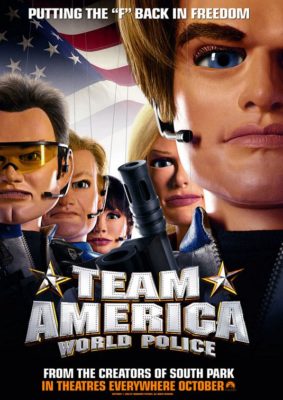Zardip is a robot alien whose body keeps breaking down. He has come to our planet in human form to learn about dieting, nutrition, exercise, and other things that would be useless for a robot.
The show’s concept shines through like a radioactive skeleton: “Mork and Mindy, but educational”. A typical episode features Zardip interacting with his new human friends, misunderstanding some heath concept in an amusing way, and being corrected. All the usual cliches make an appearance. Is there a rap song about the importance of health? Does air contain air?
I love the show’s title more than I love my family. It simultaneously manages to be clunky, overlong, grammatically challenged, redundant (is there such a thing as “unhealthy wellness”?), and if that’s not enough, it contains the word “Zardip”. Some TV guides didn’t even print the full title, shortening it to Zardip’s Search.
Zardip’s Search For Blah Blah is live action and mostly shot on the same 2-3 sets. To break things up there’s cutaway scenes featuring 2D animation, claymation, and even a few seconds of CGI (which cost a fortune in 1988), giving it the air of a variety show. It provides basic medical information mixed with dubious factoids – it repeats the “43 muscles to frown and only 17 to smile” urban legend, for example. The end credits thank a “Dr Robin Williams”, which feels like a joke.
In the late 80s and early 90s, Canadian broadcasting achieved a striking international presence, particularly in the British Commonwealth. As a boy in Australia I saw nearly everything by Nelvana and Atkinson’s Film Art ever made. The historical reasons elude me. Perhaps the syndication rights were cheaper? In any case, Zardip’s Search For Schnorp doesn’t belong in a class with Babar and Caillou. Briefly syndicated, achieving no lasting fame or notoriety; it’s one of hundreds of shows that once existed and then suddenly didn’t.
Wikipedia questionably asserts that “the show has a cult following among Canadians who attended grade school in the late 1980s and early 1990s”. This cult must have overdosed on zero sugar Kool-Aid and died from excess Healthy Wellness(tm) because I can’t find them online. The IMDB entry for Zardip’s Search For Arglebargle has just seventeen ratings (averaging 7.8/10, higher than the last Quentin Tarantino film) and only two reviews. A VHS transfer exists on Youtube with about two thousand views per episode. It likely won’t come to Netflix tomorrow, or the day after.
Zardip is played by a striking child actor called Keram Malicki-Sanchez. He turns in a powerful performance, reminding me of David Bowie in The Man Who Fell to Earth. What happened to him? I Googled his name, praying that Zardip’s Search For A Printable Title wouldn’t be among the top results. It was. Oh.
No Comments »
At age nine, anything seemed cool if it was rumored to contain swear words. I lived in awe of the Rapper Who Swears (Eminem), the Videogame That Swears (Grand Theft Auto 3), the Books That Swear (Tom Clancy’s), and particularly the Cartoon That Swears (South Park).
When I finally saw the South Park in adulthood, I was surprised. The Cartoon That Swears turned out to be an intelligent and funny show with a lot to say and a finger close to the pulse. But I never really liked the show’s cultural commentary. It always had a strained quality, with Trey Parker and Matt Stone struggling so hard to be both funny and profound that you could see sweat dripping from the storyboards. I preferred the episodes that took a lighter touch and had the kids just goofing around.
The duo’s 2004 film Team America: World Police has similar strengths and weaknesses. Lots of jokes land, but many others don’t, and there’s a clear reason why.
It’s about Team America, a covert spec-ops force who (in the opening scenes) blows up the Eiffel Tower, the Louvre, and the Arc de Triomphe while attempting to stop a terrorist attack in Paris. One of their members dies in the fiasco, and his replacement is Gary, a Broadway actor. With Kim Jong Il and terrorists from Durkadurkastan threatening to commit “9/11 times 2,356”, they need Gary’s acting skills to infiltrate a terrorist cell.
Straight away, there’s a horrible miscalculation: puppets. Nobody likes puppets, or wants to see puppets. They’re creepy. The nightmare fuel is at relatively low levels during dialog scenes, but whenever a puppet moves or does something the odd stiffness is all you can focus on. It would have been better as CG, or South Park style cutouts, or live action. Anything except puppets.
But TA:WP‘s big problem is that the geopolitical satire elements just don’t work. Who are we laughing at? And at whose expense? There’s a saying that comedy should punch up, not down (in other words, make jokes about deserving targets). I don’t agree: often it’s unclear who the “deserving” target is in a given joke and reducing comedy to a form of cultural warfare is gauche, to say the least. But Team America doesn’t punch up or down. It punches the air. And itself.
An example: the first scene involves Team America destroying half of Paris. “Okay,” I thought, “it’s mocking gung-ho American aggression.” But soon things get muddled: the terrorists actually pose a credible threat to global stability, and Team America’s methods are both necessary and successful in fighting them. The film basically chops away its own knees: creating straw men and then valorizing them.
And (as Roger Ebert mentioned at the time) it’s striking that the White House is spared as a target. Team America operates on their own, without supervision (it’s mentioned that it’s sponsored by corporations, a shot at Halliburton that goes nowhere). The implication seems to be that if a military operation ends in disaster or tragedy, it’s the fault of a few loose cannons on the ground. Nobody higher up should be blamed or held to account. Is that what they’re saying? I don’t know. What are they saying?
To be clear, I don’t care that the film is apolitical, nor do I want it to be full of Bush jokes (nothing was more hack in 2004) But when you make a movie about a complex geopolitical situation, you should have more to say than “everyone is a retarded fag, plus the military is cool”. It’s a rough bit to laugh at.
But I insulteth the film too much. A lot of it is really funny. There’s one gag as hilarious as anything I’ve seen recently, and it has nothing to do with politics. As Gary gets briefed at the top-secret Team America base, he’s told that if he’s taken prisoner he’ll want to take his own life using a special tool. You’re expecting a high-tech gadget…but Spottswood hands him a hammer. A fucking claw hammer.
There’s plenty of jabs taken at the messiah complex of certain actors. The funniest Simpsons episodes are the ones that riff off the cartooning industry, and Parker & Stone are likewise in their element when writing about showbiz. They’ve never been afraid to shit where they eat. They famously attended the 2000 Oscars dressed in drag and high on LSD, which might explain why they don’t generally get invited to nice occasions like that.
Even the Thunderbirds-esque puppets sometimes work as a source of “anti-comedy” (think Tim and Eric). There’s a moment where Gary is riding a motorbike, collides with the camera, and awkwardly flips over. It’s so jarring and dumb that it gets a laugh. I’m pretty sure that this was an actual accident left in the film.
This is the sort of film where you find enjoyment in the decoration – the occasional bit of inspired craft or filmmaking, the funny one-liners, the songs – rather than the substance. TA:WP is like scaffolding that stays up while the building at the center collapses. The satirical core of the film – which should have been its strong element – ends up just being a gaping black hole.
No Comments »
This 1969 LP contains half an hour of beach noises. “This is a joke” would be a reasonable first impression. So would “this was created and should be experienced under the influence of drugs”. After a few minutes, however, the repetitive pounding conjures images: waves curving upwards, rising and then breaking like glass, droplets descending in curtains of diamonds, sand eternally drinking, sea eternally replenishing. The ocean is an breathing lung, and this exact noise has happened over and over for as long as liquid water has existed on the planet. The LP is thirty minutes containing four point four billion years.
Listen long enough, and you start hallucinating. Your Broca and Wernicke’s areas start mistaking the crashing waves for vowels and consonents, as if the sea is speaking as well as breathing. At one point, a low, droning hum (a foghorn?) emerges through the sound of waves. It almost seems to drill through them, like an ice augur. The foghorn tells a story of man appearing and gaining ascendance over nature: but then the foghorn vanishes, and the waves remain.
Environments 1 was the work of a fascinating person from the 60s counterculture: Irving Solomon Teibel. He seems to have been somewhere between a musician, an inventor, and a con artist.
To rip the band-aid off, Environments is not what it appears. This is not the sound of nature. It’s the sound of a computer. It’s not a natural beach. It’s eight minutes of tape hacked up with a razorblade, reassembled in certain patterns, and supplemented with synthetic white noise. It contains an “ocean” to the extent that an Ashlee Simpson album contains “singing.” That it sounds like the real thing is largely because your brain was primed to expect it, and never questions that assumption.
One of Teibel’s interests was psychoacoustics: the impact of audio on humans. Although waves have existed eternally, our perception of them is highly personal, and lives and dies with us. Some people put on a fan to help them sleep, others need to turn a fan off. Stephen King writes to loud rock music, whereas I can’t write to a radio half a block away.
The potential for audio to be used as a tool of relaxation or therapy was a topic of interest in the late 60s, and in that spirit, Teibel decided to record the ocean. Using a Uher portable stereo reel-to-reel tape recorder, he recorded tapes of beaches all across the eastern seaboard of the United States of America, seeking the noises he heard in his head. His attempts failed: for whatever reason, real-life beaches didn’t sound right on tape. The missing link was neuropsychologist called Louis Gerstman, who had access to an IBM 360 at a time when mainframe computers cost around two million dollars. He and Teibel laboriously altered the tapes until they had arrived at a “right” sounding ocean that was, in fact, heavily artificial.
With this knowledge in mind, it’s easy to see where Teibel’s ocean was changed, and why. The “sentence-like” quality of the waves is deliberate: the creator wanted to evoke a language. The way they stay at precisely the same volume throughout is another choice. By the way, I’ve heard rumors that the droning noises aren’t foghorns, but Irv Teibel’s mouth.
“Listen to a computerized beach for an hour” was a rough sell, so Teibel worked over his product with consummate salesmanship. It was sold as a restfulness enhancer, and the cover plastered with exuberant testimonials (“HAVEN’T FELT SO GOOD SINCE MY VACATION”; “cured my insomnia!”; “BETTER THAN A TRANQUILIZER,”; “fantastic for making love!”) that were almost certainly written by Teibel himself.
It worked. The record was picked up for distribution by Atlantic, and it was soon selling thousands of copies. He presaged Brian Eno’s Ambient 1: Music for Airports by a full nine years, but despite this he isn’t remembered as a pioneer of ambient music. Teibel had a similar problem to Delia Derbyshire (who created the electronic Dr Who theme) – you don’t want to invent something too early, or you won’t be part of the seminal “scene” and everyone will forget to credit your innovations.
Psychologically Ultimate Seashore was side A of Environments. The reverse contains Optimum Aviary, which is just a curio. I don’t like the sound of birds, nor the shrill and irritating recording.
And apparently the seashore still wasn’t psychologically optimum enough, because the CD re-release of the 1969 vinyl contains several more changes. It’s doubled in length by (you can hear a clumsy cut where this happens), and has been equalized to take advantage of the flat response digital audio offers. A weird little joke (Teibel recording himself saying “skoosh!” or something) is excised. The LP is a remix of the ocean, the CD is a remix of a remix. Many more Environments were released after this (featuring bells, owls, thunderstorms, and more), but the first is the most famous.
Teibel described his work as “more real than real,” which raises the question: is that a contradiction of terms? Can something be realer than real? If reality isn’t to our liking, can we improve it, or does that mean it’s no longer reality?
As a child, I found a pebble at a beach that was nearly a perfect cube, as if cut with a chisel. It was a naturally-occurring rock (as far as I can tell), but it didn’t look “real” to my eye. I could have changed its shape, smashing off its corners so that it resembled other pebbles…would this have brought it closer to nature, or farther away? It’s an interesting philosophical question.
Another Teibel LP (perhaps his second most famous, after Environments) is The Altered Nixon Speech. It contains Richard Nixon’s August 15, 1973 speech, creatively edited so that he’s confessing to the Watergate break-ins instead of denying them. “My effort throughout has been burglary and bugging of party headquarters, obstructing justice, harassing individuals, and compromising those agencies of government that should be above politics.”
The recording was made in a spirit of fun – Teibel wasn’t trying to hoax anyone – but it’s an interesting “reality improvement”, from Teibel’s perspective. As a NYC-dwelling hippie of Jewish descent, he probably voted Democrat and viewed Nixon as a crook. He probably also saw his “fake” Nixon speech as closer to the truth than the one Nixon actually gave.
Computers are cheaper than they were in 1969, and although Teibel was one of the first digital tinkerers with the truth, he wasn’t the last. Farms of online trolls are forging videos to sway elections. Thousands of rappers are time-aligning and pitch-correcting their voices for Soundcloud likes. Millions of young women use Facetune to make their bodies thinner. In the accelerated evolution of digital media, it’s easy for a new reality to supplant an old one. Not everyone shares Teibel’s essentially prosocial outlook, or his sense of fun. Can we gild the lily? Should we?
Maybe the waves really are speaking. “We are not the sea.“
No Comments »



